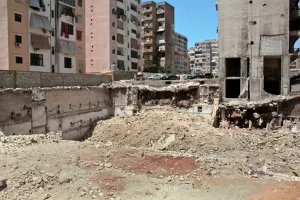What is the “Dahiya Doctrine” of the Israeli military? The first, known as the “Dahiya Doctrine,” first arose in the wake of the Israel-Lebanon war of 2006 and described a Beirut suburb that served as a bastion for the extremist group Hezbollah before being mostly destroyed by Israeli jets.
Security and Defense: While attacking civilian neighborhoods that serve as enemy command centers may appear harsh to some, many in the IDF believe that this is an essential tactic until Hamas and Hizbullah alter their behavior.
The term “Dahiya Doctrine” was initially introduced to the public by Gadi Eisenkot, a former Chief of Staff of the IDF. A residential bastion for Hezbollah, a militant Islamic Shi’ite movement hostile to Israel’s incursions on Lebanese territorial sovereignty and pro-Palestinian in its broader political agenda, was thought to exist in the suburban hamlet of Dahiya in southern Beirut.
The theory was not surprising to those who were familiar with previous Israeli methods, even though it openly rejected adhering to applicable international law when it was articulated in connection to events from 1986 and 2006. The revelation certainly caused some people in Tel Aviv to snort in distaste, since these kinds of topics aren’t usually appropriate for public discourse.
The Dahiya Doctrine summarizes Israeli tactics since the British Mandate, but General Eisenkot specifically cited it about Israel’s use of disproportionate force in 2006 to destroy Dahiya’s civilian infrastructure—a measure taken in response to what Israel perceived to be provocations by Hezbollah. It was presented as the foundation of a two-part philosophy of counter-terrorist deterrence, explaining not just the rationale behind previous behavior but also Israel’s unique claim of intention and authority to employ force in this way against non-state foes. Additionally, it was an unofficial attempt to reinterpret “military necessity” in light of Israel’s asymmetric warfare against adversarial non-state entities situated in nearby states.
Within the particular context of Lebanon, Eisenkot places the blame for the use of disproportionality on Hezbollah, arguing that the Shiite villages in the south have become “platforms for terror,” an inflammatory code word for armed opposition to Israel’s occupation.
Notably, Eisenkot makes this assertion with no attempt at all to reconcile the Dahiya Doctrine with international humanitarian law, which restricts the proportionality of any use of force in international combat situations. It also fails to acknowledge that, before confrontations with Hezbollah, Israel consistently retaliated disproportionately against its adversaries, particularly regarding acts of resistance by Palestinians, even when those acts were nonviolent and carried out in frustration with Israel’s prolonged unlawful behavior, as was the case with the Gaza Right of Return Movement, which was launched in 2018 following an 11-year punitive blockade and sporadic large-scale Israeli attacks on the defenseless civilian population of Palestine.
Gadi Eizenkot, the chief of the Israel Defense Force (IDF), later clarified the idea. “We will inflict enormous harm and devastation on any community from which Israel is fired upon, using disproportionate force. These are military bases in our eyes,” he remarked. “There has already been authorization for this plan.” In an article written for the Israeli think tank Institute for National Security Studies, Colonel Gabriel Siboni elaborated on the phrase.
Israel security analysts claim that there are indications that the policy is being applied in the current aircraft bombardments of Gaza. In response to reports of significant civilian casualties in the area, IDF spokesman Daniel Hagari said on Monday morning, “The emphasis is on damage and not on accuracy.” When asked if Israel is currently implementing the idea in Gaza, security expert Yoni Ben Menachem, who has close contacts with the Israeli military, answered, “Definitely.” He went on, though, calling this “psychological warfare… to scare civilians away from Hamas targets.”
“The general concept that Israel will inflict considerable damage and destruction to restore deterrence does apply,” stated Dr. Daniel Byman, a conflict expert at the Centre for International and Strategic Studies and US State Department counselor.
“There is a trade-off between an operation that reduces damage to the other side and increased likelihood of costs for Israel,” he stated. “I believe that this time they will adopt a strategy to shield Israeli soldiers while causing more damage to the Palestinian side.”
The doctrine has been questioned by legal scholars. The bombing of buildings, including local government offices and a prison, “constituted deliberate attacks on civilian objects in violation of the rule of customary international humanitarian law (IHL), whereby attacks must be strictly limited to military objectives,” according to a 2009 UN report that accused the IDF of using it in the conflict in Gaza that same year.
The IDF Operations Directorate, housed beneath the military’s strongly guarded underground command center, known by its Hebrew name, Bor, or “pit” in English, is responsible for creating the preparations for upcoming battles. The Bor is accessible by a sizable steel door that is sealed shut in the case of a non-conventional attack. It is housed in the Kirya, the IDF’s Pentagon in Tel Aviv. A large notice in front advises guests to take the batteries out of their phones before entering because adversaries can still listen in even when a phone is turned off.
The staircase seemed to go on forever. Operations officers go over maps and plans related to a potential conflict with the nation’s northern neighbor behind a door marked “Northern Front – Syria” on one floor. The Gaza and Lebanon doors are located down the hall.
After descending two more flights of stairs, one reaches the conference room of the chief of general staff, where the IDF’s senior brass convenes virtually every week to discuss matters of the utmost secrecy and evaluate operational plans.
Except for a U-shaped table and a wall covered in plasma TV screens, video cameras, and photos from earlier meetings documenting the Second Lebanon War in 2006, the 2009 Operation Cast Lead in the Gaza Strip, and the 2005 unilateral pullout from Gaza, the room is very empty.
The Beirut area known as “DAHIYA” is exclusively accessible to Hizbullah members who possess membership cards. Because the neighborhood’s huge apartment buildings were constructed over Hizbullah bunkers and served as Hizbullah command and control centers, the IDF attacked them during the 2006 conflict.
The debates over the doctrine are more about the effect that these strikes have on Israel’s adversaries than they are about the Goldstone report. Opponents of this approach contend that Hizbullah and Hamas are so well-coordinated that it is nearly hard to inflict a mortal blow to them, as one would against a traditional force. Supporters contend that hitting a terror group’s command center can have this kind of impact.
The IDF is currently engaged in what one operations planning officer refers to as the “Collage War,” since IDF commanders will encounter elements of conventional, terror, and guerilla warfare while confronting groups such as Hamas or Hizbullah. To put it another way, a commander invading Lebanon would encounter guerilla tunnels, conventional anti-tank missiles, and attempted kidnappings.
Therefore, the battle cannot be ended by destroying a single point of gravity. In contrast, Israel retook the Suez Canal during the Yom Kippur War in 1973, signaling Egypt’s defeat.
Judge Richard Goldstone views Dahiya and the Gaza Strip as being the same place, despite their distance of hundreds of kilometers. Goldstone cities OC Northern Command Maj.-Gen. Gadi Eizenkot in his report to the UN, to which the government is due to reply shortly, supports his conclusion that Israel routinely demolishes homes and buildings when conducting operations in the Palestinian Territories.
In an interview from October 2008, Eizenkot declared, “Whatever happened in the Dahiya quarter of Beirut in 2006 will happen in every village from which Israel is fired on.” We’ll exert excessive force on it, wreaking havoc and causing a tremendous deal of damage. From our perspective, these are military bases rather than residential communities.
Goldstone came to the following judgment after hearing these and other statements from Israeli officials: “Violence against civilians and disproportionate destruction was part of a deliberate policy.”
Goldstone even sent Eizenkot a letter informing him that his quotes would be included in the report.
It makes sense to assume that receiving such a message would discourage Eizenkot from saying the same thing in the future. On Sunday, however, he demonstrated the exact opposite when he said that the IDF would keep implementing this philosophy going forward at a conference in Tel Aviv.
Regarding plans to destroy houses in villages in Lebanon where Hizbullah has command centers and stores rockets, Eizenkot declared, “Hizbullah is the one that is turning these areas into a battleground.” “Hopefully this will stop them, but if not, we have to explain to everyone that Hizbullah is to blame for this as it is constructing its combat zones inside these villages.”
The same can be said of Hamas. Hamas has not altered its attack-launching tactic of utilizing civilian infrastructure since Operation Cast Lead. On the opposite. Additionally, it is expanding its tunnel networks across Gaza. To discourage IAF strikes, command and control centers are being stationed on the ground floor of residential buildings.
Because of this, the consequence of a confrontation in the future is probably going to be similar to what happened last winter. For as long as Hamas fires rockets from schoolyards and keeps its armaments hidden in mosques and people’s houses, the IDF will be forced to move into populated areas where the likelihood of collateral damage is higher.











